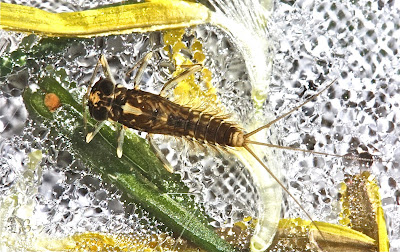Two weeks ago, as I anticipated my fly fishing trip to Montana, our guide sent me the following photo of a mayfly dun that had landed on his oar.
(photo by John Herzer, Blackfoot River Outfitters)
He asked if I knew what it was. I didn't, but I dug around and found an exact match on Troutnut.com (http://www.troutnut.com/hatch/140/Mayfly-Ameletus-oregonensis-Brown-Dun):
Ameletus oregonensis, the Brown Dun.
I hoped that I might find
A. oregonensis nymphs when I got to Montana, so I was pretty sure what I had when I found these critters in the Blackfoot and Bitterroot Rivers.
As it turns out, I was wrong -- but let's see how I arrived at that conclusion. I found the answer in an article by Jacek Zloty and Gordon Pritchard, "Larvae and Adults of
Ameletus Mayflies (Ephemeroptera: Ameletidae): From Alberta",
The Canadian Entomologist (129), pp. 251-289. Larvae are keyed out on pp. 256-257, with important illustrations of critical features in Figures 17, 18, 20, 23 and 28.
____________________
Zloty and Pritchard, pp. 256-257
"1. Ganglionic markings present on abdominal sternites 2-8 (Fig. 18E).....2
Ganglionic markings absent (Occasionally visible on sternites 7-8 or on sternite 8...3"
I had no idea what "ganglionic markings" looked like until I looked at that illustration (p. 279). It's hard to explain. There's a dark pod-shaped dot on the anteromedial edge of the sternites, with parenthetical marks -- ( )to each of its sides. Here's a look at the sterna on our nymph.
No anteromedial dark spots, just a pair of light, anterolateral spots on each of the segments. So, on to number 3.
"3. Posterior margin of abdominal sternites 6-8 with numerous spines (Fig. 28A, B) ....
4
Posterior margin of abdominal sternites 6-8 without such spines.....
6
There
are spines on the posterior margins, but let me show you my photo later.
"4. Basal two-thirds or middle one-third of caudal filaments with alternating dark and light rings every two or three segments; mesal gill extension of middle gills about 50% of gill blade width (Fig. 23F); colour pattern of abdominal tergites 8 and 9 as in Figures 19C and 20B; final-instar larvae occur early in the season (April to June)....
5
Caudal filaments without alternating dark and light rings....
6"
Here's a look at the caudal filaments, and yes, the middle one-third of the caudal filaments do have alternating dark and light rings,
and the colour pattern matches what we see in Figures 19C and 20B. Terga 8 and 9 are light, as are terga 1-5: 6 and 7 are dark.
On the "mesal gill extensions of the middle gills...
I'm not sure what is intended. Still, the gills on our nymph are an
exact match for the gill pictures in Fig. 23F, so I guess we're good to go. On to item 5.
"5. Posterior margin of abdominal sternites 6-8 with numerous large spines at the middle (Fig. 28A)...
oregonensis
Posterior margin of abdominal sternites 6-8 without large spines at the middle but with numerous small spines laterally (Fig. 28B) ....
subnotatus"
We find the latter on on our nymph. I couldn't get a very good photo of this, but I hope you can make out the tiny lateral spines.
__________________
Ameletus subnotatus. At 13-14 mm, it's a pretty big nymph.
This is a mayfly that is found from East to West in Canada, but in the U.S., it's only been found in CA, CO, MT, UT, and WY. Oh, and with the similar dorsal pattern of
A. subnotatus and
A. oregonensis, I'm not surprised that the duns look exactly the same.
_____________
P.S. Donald Chandler has posted a photo of
Ameletus subnotatus at: http://www.discoverlife.org/mp/20p?see=I_DSC484&res=640. On his nymph, the dark bands on the caudal filaments are basal, not in the middle

























































